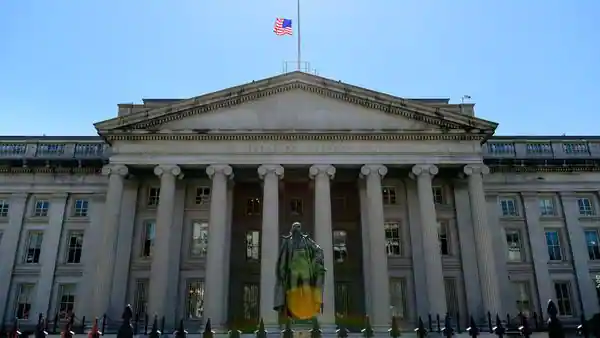Under the surface, other factors drove the selloff in U.S. government bonds, pushing prices down and yields up, according to investors and analysts. One factor was heavy selling by investors in Japan who were locking in investment returns for their year-end.
The yield on the 10-year Treasury rose from close to 1% at the end of January to an intraday peak of over 1.77% on Tuesday.
Banks and insurers in Japan put extra impetus into a wave of global selling in February, according to investors and analysts. It was prompted by efforts to finalize their investment returns for their financial year ending Wednesday.
Dai-ichi Life Insurance Co., one of Japan’s major insurance firms, said it had been selling some U.S. Treasurys and reinvesting in sovereign and corporate bonds in other currencies. It wouldn’t give further details, but said it was working on investment plans for the new fiscal year.
Large Japanese investors have collectively made net sales of ¥2.815 trillion, equivalent to $25.5 billion, worth of foreign bonds since the start of February, according to Ministry of Finance data up to March 20, the most recent available.
It wasn’t only Japanese firms. Seoul’s Kyobo Life Insurance Co. Ltd. was also a seller of longer-dated U.S. Treasurys, according to Matt Lee, head of overseas investments at the company. “There’s a high chance that U.S. interest rates will continue to rise,” he said.
One sign that Asian investors led the selloff in Treasurys was the timing of the market moves, according to several investors. Some Treasury auctions struggled in late February. Analysts at that time spoke of a buyers’ strike among Asian investors causing a shortfall in demand.
Guneet Dhingra, head of U.S. rates strategy at Morgan Stanley in New York, tracked the differences in the timing of market moves. He found that during February, when the Treasury selloff accelerated, most of the upward move in yields came during Japanese trading hours.
In March, up until the recent Fed rate-setting meeting, the selling was more split between Tokyo and London trading hours. In recent days, buying during Asian hours has led yields back down from their peaks, Mr. Dhingra said.
The Japanese selling wasn’t driven by any fundamental concern or changes in investors’ views of Treasurys, Mr. Dhingra said. Instead, banks in particular were looking to offset bond losses against equity gains.
“The selling was driven by Japanese banks looking to smooth the volatility of their portfolio returns for the year-end,” he said.
The rise in yields caused by this selling affected the psychology and market views of other investors, who reacted and began selling more themselves. The pressure moved through the market in March, into London hours and then early New York trading.
Some of the biggest Japanese investors, such as the Government Pension Investment Fund, Japan Post Bank and the Norinchukin Bank, a large lender for Japanese farmers, haven’t disclosed recent Treasury holdings and declined to comment.
Foreign buyers are an important source of funding for the U.S., while Treasurys are a safe home for dollars for banks in Asia and countries elsewhere that have large export industries. The dollar is the main currency used in global trade.
Foreign investors’ share of the Treasury market has fallen in recent years as issuance has grown. At the end of 2013, foreign investors owned more than 43% of all Treasurys, according to data from the Securities Industry and Financial Markets Association, a trade body. Their share was less than 30% by the end of 2020.
Asian investors broadly are concerned by the extraordinary supply of Treasurys to be sold this year, according to David Beale, who covers emerging-market institutions globally for Deutsche Bank from Singapore. Deutsche Bank estimates that Treasurys outstanding could grow by $1.7 trillion this year.
International investors aren’t likely to be put off by the flood of planned issuance, said Gareth Colesmith, head of global rates at Insight Investment in the U.K. “I don’t think it’s about perception of the U.S. as a credit risk yet, although if this level of spending and debt growth persists, you will eventually see a ratings downgrade,” Mr. Colesmith said.
The good news for Treasury markets is that Japanese investors’ sales have slowed. They could also start buying again when the new financial year begins in April. It might not happen straight away, though the extra yield that U.S. Treasurys offer over Japanese government debt has grown.
Japanese investors are likely to be cautious while the market is volatile but would have to return eventually, according to Tsuyoshi Ueno, an economist at NLI Research Institute, a unit of Nippon Life Insurance Co.
“Additional returns from U.S. Treasurys and other foreign bonds are important sources of income for Japanese investors,” Mr. Ueno said. “They have no choice but to buy.”
Japanese investors can earn a 1.3% yield on 10-year Treasurys including currency-hedging costs, according to Mayank Mishra, macro strategist at Standard Chartered in Singapore. That is double the yield on a 30-year Japanese government bond.
Asian investors, particularly those in Japan, would be drawn back to Treasurys because yields on other safe debt are so low, according to Gary Smith, managing director at Sovereign Focus, which provides research and advice to central banks and sovereign-wealth funds.
“Japanese insurers or Asian central banks won’t look at recent performance and think: ‘We’ll buy German bunds instead,’” he said. “Negative yields are a big problem for central banks as owners.”
This story has been published from a wire agency feed without modifications to the text.
This article is auto-generated by Algorithm Source: www.livemint.com


